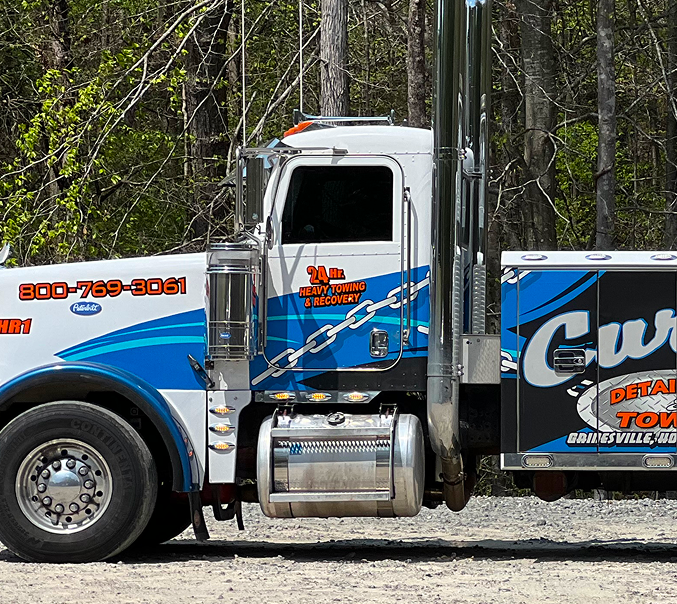When a large tractor‐trailer rig experiences a rollover, the consequences are often serious, costly and complex. This kind of incident is far more than a simple breakdown—it demands rapid professional response, specialist equipment and deep experience. For companies and drivers operating heavy vehicles, it’s critical to understand both the causes of Semi truck rollover and how a qualified heavy-duty towing and recovery provider can step in to restore safety and get operations moving again.
What is a semi-truck rollover?
A rollover occurs when a tractor-trailer or large commercial vehicle tips onto its side or even flips over due to forces acting on it during normal or abnormal driving conditions. In many cases the trailer portion begins to lean or tilt, the vehicle becomes unstable, and the rig ends up on its side or roof.
Why they happen
There are multiple factors that contribute to rollovers for semi-trucks, including:
- High centre of gravity: Large rigs carry heavy loads and tall profiles; when they take curves, change lanes, or navigate uneven terrain, they’re predisposed to tipping.
- Improper loading or shifting cargo: Unevenly distributed loads, or cargo that moves in transit, can destabilize the trailer and cause it to lean badly during maneuvers.
- Speed and abrupt maneuvers: Taking a turn too quickly, steering sharply, or overcorrecting from a loss of control can trigger a rollover.
- Poor road or weather conditions: Slippery surfaces, wind, debris or faulty road design can all play a role in destabilizing a large truck.
- Maintenance and equipment issues: Worn tires, faulty brakes or suspension problems increase the risk of a rollover event.
Because rollovers often involve large mass, shifting loads and complex vehicle geometry, the cleanup, recovery and towing task is significantly more demanding than for passenger vehicles.
The importance of specialised recovery services
When a semi-truck rollover happens, the response must be fast and technically sound. That’s where a specialist heavy-duty recovery company comes in. For example, a service provider that’s set up for heavy-duty towing will be prepared for incidents such as rig rollovers, overturned loads, and large-scale vehicle recoveries.
Key aspects of a proper recovery service include:
- 24 / 7 emergency readiness: These incidents can happen at any time of day or night, on highways or rural roads.
- Heavy‐duty equipment: Rotators, winches, large wreckers and flatbeds designed for tractor-trailers are required.
- Experienced crews: Operators must understand safe rigging, load handling, traffic control, and the physics of large‐vehicle rollovers.
- Damage mitigation: The goal is to recover the rig with as little additional damage as possible and to minimise disruption to the roadway.
- Coordination with other services: Police, highway agencies, environmental cleanup (if cargo is hazardous), and the fleet or company need to be coordinated.
What happens during a rollover incident?
A typical sequence for a rollover recovery might be:
- A tractor-trailer rolls over on a highway due to a load shift or abrupt manoeuvre.
- Dispatch is called, and a heavy-duty towing crew with suitable equipment is sent.
- The crew arrives, secures the scene (traffic control, safety perimeters), assesses the rig and the cargo condition.
- Using rotators and winches, the rig is righted, stabilised and moved onto a transport bed or wrecker.
- The cargo may need to be transferred or re-loaded; damaged material, debris or spillage is handled.
- The rig is transported to a repair or storage location, and the roadway is cleared for normal traffic.
Why the right provider matters
Using a standard car tow truck or an inexperienced operator for a Semi truck rollover is risky. Without the right gear or knowledge, further damage, delays and safety hazards can compound the incident. Conversely, a dedicated heavy-duty recovery service offers:
- Rapid and appropriate response, minimising downtime.
- Specialist capability, reducing risk of secondary incidents.
- Local knowledge, which is especially important for operations on state highways, rural roads or complex access points.
- Professionalism and insurance—essential when dealing with expensive commercial equipment, cargo liability and regulatory considerations.
What you can do to reduce rollover risk
While some factors are outside of a driver’s control, the following precautions can help reduce rollover risk:
- Ensure careful and correct loading of cargo: proper weight distribution, securement and checking of shifting loads.
- Maintain safe speeds, especially in curves, on slopes or in changing road conditions.
- Perform regular maintenance checks: tires, brakes, suspension, load restraints.
- Be alert to road and weather conditions: adjust speed and driving style accordingly.
- Know when to stop: fatigued driving, heavy winds or bad surface conditions increase risk.
A rollover involving a semi-truck is one of the most serious incidents a commercial fleet or driver can face. The physical size and mass of the vehicle, potential cargo shift, and road safety implications make it a high-stakes event. When such an incident happens it demands more than a regular tow—an experienced, well-equipped heavy-duty recovery service is needed.
By choosing a provider that explicitly handles incidents like overturned rigs, load transfers and large-vehicle recovery, you are better poised to respond quickly, minimise disruption and ensure safety. If you operate trucking assets, commercial fleets or manage cargo operations, having a trusted heavy-duty recovery partner on call is not just an option—it’s a necessity.





Comments